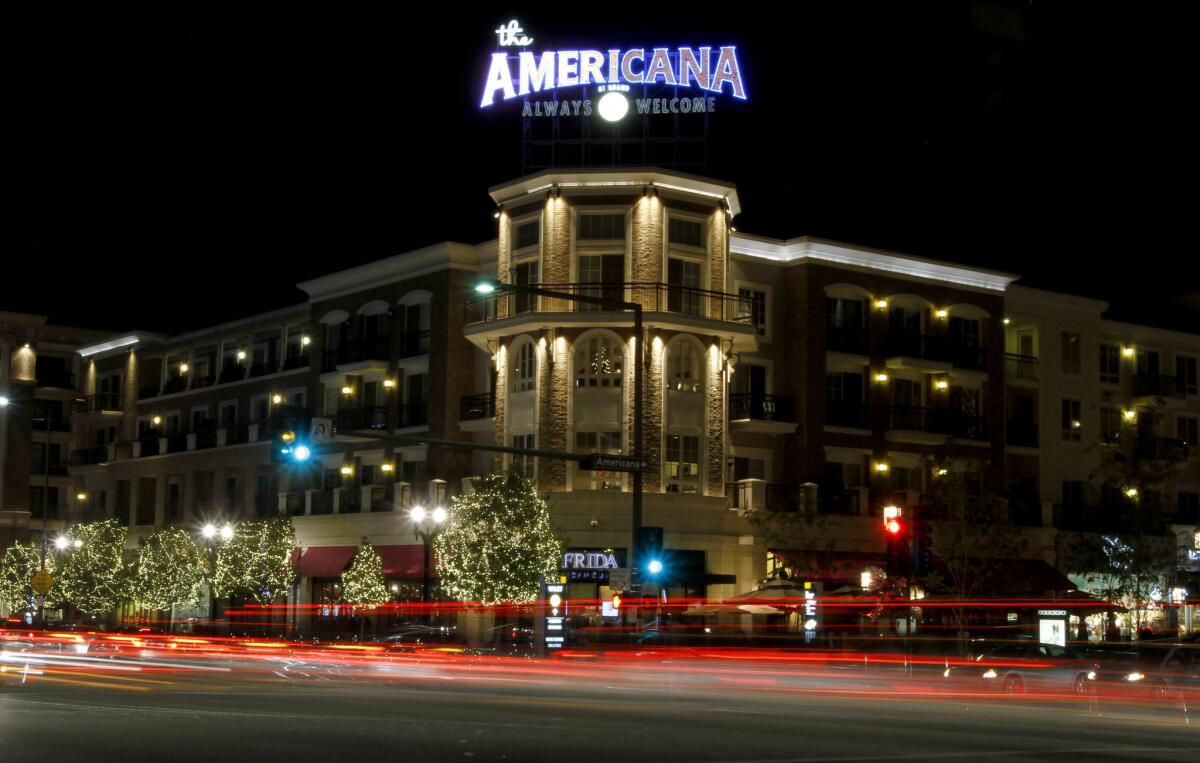Glendale’s recent growth built on a foundation of years-old decisions

The Americana at Brand in Glendale, on Saturday, Dec. 21, 2013.
- Share via
Downtown Glendale’s future reveals itself a bit more each day as multistory, mixed-use developments continue to build upward.
There are more than 20 projects in various stages of construction along downtown’s main arteries: Brand Boulevard and Central Avenue. Three large mixed-use buildings have opened in the last three years, equating to about 700 residential units. This amounts to a quarter of the 3,100 apartments approved by the City Council in the downtown sector in the past several years.
Downtown construction was a major issue in the recent City Council election, one that saw two of the architects of the development plan leave the dais — one involuntarily. The construction cranes that dot the area have had decidedly mixed reviews, and city officials have, so far, taken a “wait and see” stance toward potential congestion issues.
This massive influx of apartments and downtown dwellers has changed not only the skyline, but how residents of the Jewel City see their community.
The Plan
The developments are products of the Downtown Specific Plan, adopted by the council in 2006, that gave incentives to developers to build bigger and taller structures within the borders of downtown.
The long-term goal was to create a so-called “18-hour city” where people drove less, walked more and socialized in the downtown area after work.
Betty Porto, owner of the eponymous Brand bakery and cafe, said her customer base has grown to include locals instead of mainly fans visiting from other cities.
“Everybody just used to work here and leave, but now that’s changing, now more people live here,” she said.
The changing city worries Councilman Vartan Gharpetian, who was elected earlier this year. He said his colleagues approved too many projects too quickly. Some of those council members, however, respond that the specific plan largely tied their hands, placing the blame on its original signers.
Gharpetian singled out the under-construction building at Central and Sanchez Drive as problematic. The five-story,
192-unit development lacks ground-floor retail, something he said goes against promoting a pedestrian-friendly environment.
“You need to have a seating area, a shaded area, lighting with an art component or a water feature,” he said. “It has to be inviting. If the plan is to have a long wall go from one block to another, it doesn’t create that environment.”
Red Carpet Premiere — 1997-2005
The opening of the Dreamworks Animation campus in the late 1990s, complete with the sights and sounds of a Hollywood premiere, laid bare the paucity of food and entertainment options in the city center.
While the studio is located about 2 miles northwest of downtown, its employees started moving to the area and visiting downtown eateries, said Community Development Director Philip Lanzafame.
“[Dreamworks Animation] was an important development because what happened out in the corridor had an impact in the downtown,” he said.
About a year before the Dreamworks campus opened, members of the City Council at the time adopted what would be the first collective vision to improve downtown and try to draw in more visitors: the Downtown Strategic Plan.
“That’s really setting the blueprint for the Downtown Specific Plan, which ultimately implemented that vision,” Lanzafame said.
The construction of the 625-space Orange Street Parking Structure followed in 2000.
There were even whispers of the Americana at Brand as early as 15 years ago, Lanzafame said.
The Americana: 2006-2012
In 2004, Glendale residents went to the polls to approve or reject developer Rick Caruso’s plan to erect a 16-acre shopping center on a long-vacant lot.
Voters ultimately approved the project, which was among the first to bring new residential units to the heart of downtown: 100 condo units and 238 apartments.
“Most cities near Glendale have been much more aggressive and much more successful [at attracting retail],” Caruso told the News-Press 11 years ago. “This is Glendale’s last opportunity to get it done.”
After the Americana at Brand opened in 2008, other developers with grand visions of mixed-use projects began to take note.
“It was the unheralded and unequaled success of the Americana that brought intense attention to downtown Glendale,” said Mayor Ara Najarian, the only current member to have voted for the Downtown Specific Plan.
Despite his initial approval, he became a critic of the process in recent years when the flow of building applications sped up with no signs of slowing down.
Along with growth would be the unknown impacts on things like water consumption and traffic, said resident and development critic Rachel Melikian.
“The traffic is already unbearable,” she said. “What was city traffic now looks like freeway traffic.”
The Boom: 2012-present
Despite the initial ardor, construction slowed or stopped as the Great Recession began.
One of the first to be approved mixed-use projects, Eleve, didn’t open its doors until 2013.
It was around that time when dozens of applications flooded City Hall and were approved one after another by the council.
“There was a bunch of pent-up demand,” said City Manager Scott Ochoa.
With developers less reluctant to spend, buildings opened, and younger, wealthier people began to move downtown in droves.
But Najarian, who voted against most proposals in the past few years, said he hoped the growth would have been more gradual, over 10 or 15 years, not two or three.
While Councilwoman Laura Friedman voted in favor of many recent proposals, including the 475-unit Citibank project, she too believes developments were too rapidly approved.
She said she would have preferred to have the projects spread further apart.
“It would be much more comfortable, we’d know what the impacts were going to be,” Friedman said. “It would just be more comfortable to see how the designs are working with the buildings, the mix of different types of units and try to fill in what we needed.”
But if a project complied with zoning rules, the council didn’t have much authority to reject a proposal unless it was based on a variance or the design, Friedman said.
Recently, the council revised the specific plan to raise the bar for developers on certain categories.
But Melikian said she already fears the arriving units and their high price tags — a $2,000-a-month studio for example — will motivate landlords of much older buildings throughout Glendale to start charging higher monthly rents.
“They’re going to raise the rents to match [the new] rents … it’s going to get worse and worse,” she said.
Najarian said he’s worried about what 3,000 or more occupied units would do to current congestion levels.
“The City Council needs to act quickly if in fact we see problems in traffic and problems in public safety,” the mayor said. “I’m committed to maintaining the quality of life for the city.”
But it remains to be seen if the city can bring in enough resources — that is, money — to do just that.
“We have to live within our budget, we can’t exceed our budget,” Ochoa said. “If that means redeploying our existing resources … then that’s what we need to do.”
The city manager noted, however, sales tax revenue dollars will be coming in from the commercial tenants occupying the ground floors of many mixed-use developments. Finance officials estimate raking in about $50 million on property tax dollars in 2015-16, a 6.6% increase from the year before.
The downtown growth — spearheaded by the arrival of the Americana — also helped attract some of the most popular brand names at the moment, such as Chipotle and Tender Greens, as well as nightlife venues like the Famous and Moose Den, Lanzafame said.
And while more and more people will begin living in downtown, Ochoa said he hopes those moving in will be walking more than driving.
“Make no mistake, the primary focus of the Downtown Specific Plan is building a dynamic and healthy urban core on a suburban scale that will benefit Glendale for the long term,” he said.
--
Arin Mikailian, arin.mikailian@latimes.com
Twitter: @ArinMikailian
